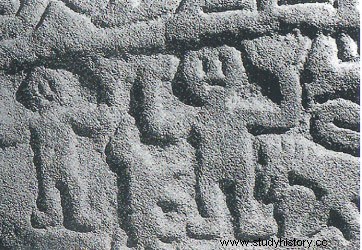Dvergr (pl. dvergar), idea of “twisted”.
Contrary to our modern folklores, the ancient Scandinavian dwarfs were not small but had our size. It was the Church that reduced them to their present status, in accordance with its policy of systematically devaluing all pagan creatures. Even thus reduced, their vitality attests to their antiquity. Ancient sources put them on the same level as the alves, and they converse willingly with the gods. Modern Scandinavian folk tales, especially Norwegian ones, will ensure their fortune. The medieval thulur (poems which are enumerations of proper names) provide us with a good hundred names of dwarves, many of which are eloquent.

On first analysis, the dwarves seem to have been the dead, as the word for them ("twisted") suggests; indeed, the deceased were buried in the fetal position and not, as nowadays, horizontal. Some of their names like Dâinn (Death), Blâinn (Blue, that is to say black in this universe) or Nâr (Corpse) go in the direction of this interpretation. As such, they are fundamental because it is not excluded that a very first stage of this religion consisted in venerating the spirits of the dead. As the dead, they dwell underground, preferably in rocks and mountains - the echo is said to be dvergmfzli (dwarf language) or, in modern Icelandic, bergmàl (mountain language) -, and cannot bear the sight sun:the trick of anyone who wants to destroy them is to expose them to the light, which petrifies them.
They are also great magicians (as such, fjôlkunnigir, "who know many things") and the holders of the knowledge of primordial occult realities - testify to names like Fjôlsvidr ("of multiple knowledge"), Râdsvidr ("Savant Adviser”) or Alvfss (“Very learned”), the dwarf whom Thôrr addresses in the Alvissmâl to know the heiti or obligatory figures in skaldic poetry. They contribute to the elaboration of the poetic nectar by mixing the blood of a being supremely skilled in the matter called Kvasir with honey. They also play a cosmic role:the vault of the sky, made of the skull of the primitive giant Ymir, is supported by four dwarves whose names are those of the cardinal points:Nordri, Sudri, Austri and Vestri.
They are also first-class goldsmiths or craftsmen, blacksmiths and treasure keepers. Popular literature will make a fortune on this theme. They are responsible for the manufacture of wonderful objects such as the hammer of Thôrr (Mjôllnir), the golden hair of Sif, wife of Thôrr, the Draupnir ring, the great necklace of the Brfsingar that the goddess Freyja covets in the Sôrla thàttr , the divine boat Skfdbladnir which has the property of folding up to be transported in the pocket of the god who owns it, or even the magic "chain" Gleipnir with which we will be able to attach the wolf Fenrir, or the marvelous boar Hildisvfn.
They oppose the giants, with whom they share many prerogatives, and are confused with all kinds of supernatural creatures, especially the alves. Their composite and fairly impure image (Snorri Sturluson likens them to the “black alves”, dôkkklfar) can only be explained by their great antiquity.
